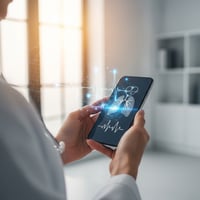Imagine Morgan, a dedicated professional with a passion for morning runs. Despite their commitment,...
Enhancing Biometric Security with SmartSpectra's Face ID Liveness Detection
In the evolving landscape of cybersecurity, the sophistication of threats has necessitated equally sophisticated countermeasures, particularly in the domain of biometric authentication. Traditional authentication methods, while initially offering a higher level of security than passwords or PINs, have been increasingly compromised by spoofing techniques, including the use of high-resolution photos, videos, and even sophisticated 3D masks.
The key security question is no longer, “Do you know the password?” … it is now “Are you the person who set this password with me in the first place?” Crucial to this is not only matching the face of the person typing in the password but also verifying that it is the live person and not a faked image of the live person. Wow!
A notable advancement combatting these vulnerabilities and meeting the “proper live person” validations is the integration of liveness checks into biometric authentication systems, enabled by the SmartSpectra SDK's approach to Face ID verification and rapid vital signs detection.
The SmartSpectra SDK augments biometric authentication strategies by incorporating a two-fold mechanism designed to ensure the presence of a live subject during the authentication process. Initially, it prompts the user to perform a simple action such as blinking, which serves as an immediate filter against static spoofs like photographs. However, the SDK's most innovative feature lies in its ability to detect a live pulse signal within the face. By leveraging advanced imaging and signal processing algorithms and the camera on any smartphone or webcam, the SDK analyzes subtle variations in the video feed that correspond to the user's heartbeat and other critical life signals. This method has been tested to work in even dim lighting, across the full range of skin colors and across all age and fitness classes of different kinds of users – typically in less time than it takes a digital thermometer to get a reading – thereby maintaining user convenience without compromising security.
From a technical standpoint, the pulse detection mechanism operates on the principle of photoplethysmography (PPG), a technique used in medical devices to detect blood volume changes in the microvascular bed of tissue. By applying this principle, the SmartSpectra SDK can discern between real human skin and artificial materials used in masks or other spoofing artifacts.
Addressing privacy concerns, the SmartSpectra SDK is designed with data protection in mind. The authentication process is performed in real-time right at the point of verification using a smartphone or fixed mounted camera. Facial capture can be completely anonymous and merely needs to match a previously seen face, so no Personally Identifiable Informations (PII) is required – minimizing data exposure risks. Additionally, the SDK can be configured to work entirely on-device, ensuring that sensitive biometric data does not leave the user's device, further reinforcing privacy.
Compared to existing authentication methods, the SmartSpectra SDK represents a significant advancement in both security and user experience. Traditional biometric systems, while convenient, have often struggled with the need for complex hardware or fixed installations on top of now needing to worry about the new spoofing vulnerabilities. In contrast, the SmartSpectra SDK's liveness detection and on-device processing, which can be done with the portability, ease and “always there” availability of using one’s own smartphone, provides the basis for a far more secure and privacy-friendly solution.
Security best practices recommend a layered approach to authentication, and security and password applications based on the SmartSpectra SDK fit well within such a strategy. Organizations implementing this technology should do their own testing and training is minimal since everyone already knows how to take a selfie on their smartphone. It is as easy as that.
Ongoing training on the importance of privacy settings and permissions, particularly in applications requiring biometric authentication, will remain an important part of annual training protocols.
Looking forward, the new focus on the “Is it really you?” questions and the continued evolution of spoofing techniques will undoubtedly challenge the efficacy of current anti-spoofing measures. However, the adaptive nature of SDKs like SmartSpectra, which can integrate advancements in signal processing and biometric analysis, promises a dynamic response to these threats.
As biometric authentication becomes more pervasive, the development and refinement of liveness detection technologies will play a crucial role in maintaining the integrity of secure authentication systems. The SmartSpectra SDK's innovative approach to leveraging biological signals for enhanced security, combined with its speed and ease of use, is a compelling example of how technology can stay one step ahead of potential vulnerabilities, safeguarding user identity in the digital age.





